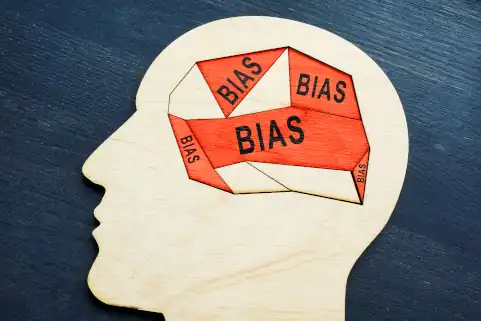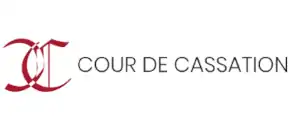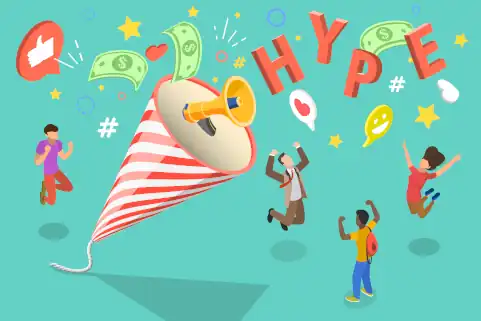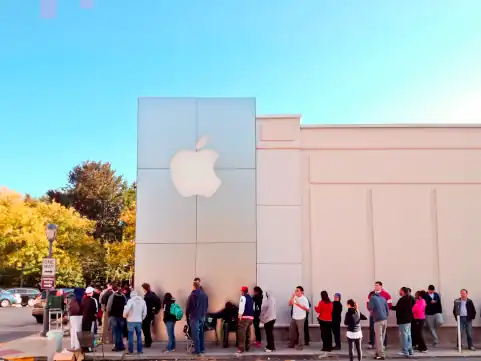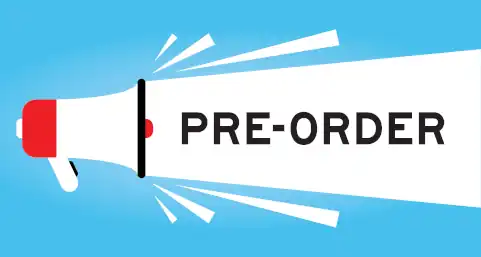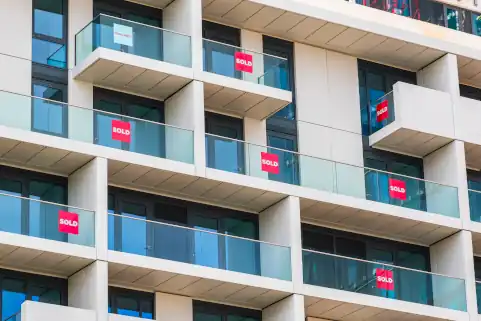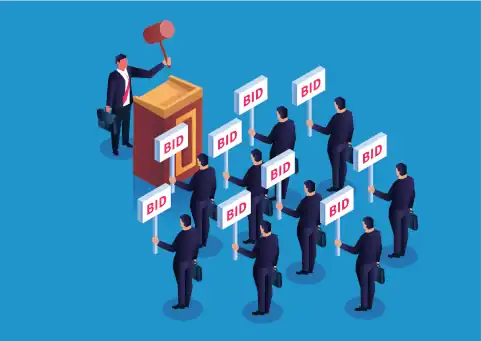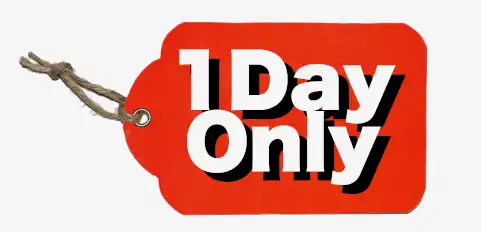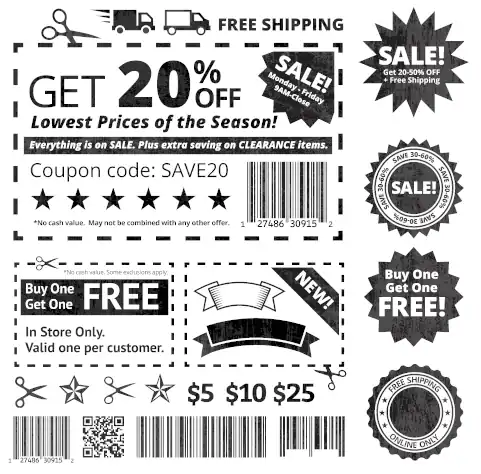Scarcity vs urgency
These two marketing terms and tactics are often confused and intertwined. There's no harm in that; they're both valued strategies that drive sales and create the same end result in scarcity marketing campaigns — increased demand.
Scarcity makes buyers believe if they don't act fast, the item will sell out, and they'll miss out on a valuable opportunity.
Urgency makes buyers believe if they don't act fast, the promotion will end, and they'll miss out on a valuable opportunity.
See? Similar, but not quite the same — yet what do you care? You only want to know whether you can boost sales for your company with either marketing strategy. You can use either strategy as a sales tactic, or both.
Using scarcity in marketing
So how do we use these subconscious desires to sell more products with product scarcity marketing tactics?
Hype. That's a big, powerful word for one with so few letters, translating into a feeling of desirability that drives website consumers to buy, converting potential customers to loyal customers, whether the marketing hype is real or false, on social media with millennial consumers or word of mouth.
What makes hype so successful?
Social gratification – We all need to feel like we are special. Being part of a limited group, fortunate enough to be included in an invitation-only event, or obtaining an item with limited availability or limited supply satisfies that need, even if that group is part of an email list 100,000 strong.
Elitism – Would you rather drive a Ferrari or a Ford Fiesta? Fiestas outnumber Ferraris by their hundreds. Yet owning what others can't afford or don't have access to delivers a sense of empowerment and elitism, putting you in the company of an elite group, even if it means stretching our resources to obtain them.
Exclusivity – Owning one piece of a limited edition run of a particular scarce product makes us feel blessed. It's why people collect art, antiques, or rare objects. Exclusivity sells.
Sense of achievement – When you land those concert tickets none of your friends managed to get hold of, you automatically win bragging rights. You've got something they haven't and earned it with pure determination and effort. Be honest — a good website deal feels good, doesn't it? We all love discounts, don't we?
Security and self-preservation – Let's consider the toilet rolls and hand sanitiser selling out issues during lockdown. We thought our lives would be impacted without such necessities, even though manufacturers continued production as usual, and the product was only scarce because we bought so much of it. We stocked up our bathroom store primarily out of fear of product scarcity but also from self-preservation and a little selfish greed. Time limited sales are another way that scarcity tactics tap into this evolved drive.
We're innately competitive – Another cognitive bias. Subconsciously, we all want to win, whether we dare admit it or not. We want to be praised, loved, and appreciated. That comes with owning skills others don't possess or being better than everyone else at that one thing. Sometimes, owning a limited quantity product is enough to feel better than everyone else, for example.
Artificial scarcity marketing
Let's take a quick look at eBay – Multiple bidders compete for a single item, often bidding more than the retail value of a new version. Only one person can win, so obviously, there aren't possibly enough items to go around. The result? More sales. That's an example of great scarcity marketing.
eBay gamifies buying, and that's why it's known as 'winning' an auction and a purchase.
Now, how about Apple – every new version of the iPhone creates massive demand, with buyers queuing outside Apple Stores around the country all day long just to get hold of a model that will be readily available in a few weeks' time.
It's just a phone amongst millions of models, so why do customers go to such great lengths to be the first to get them? Apple products are renowned for running out on release, whether that's because Apple can't keep up with demand or manufacture just enough of them to keep creating that exclusivity. That's an example of smart scarcity marketing tactics - and we should know, as we have queued thousands of people for iPhone launches with Queue-Fair online queues. Remember whenever you launch new products, it's a scarcity marketing opportunity with each new product for you too.

Brand strength and bonus publicity
This is a great point to note, as by doing that at every launch, Apple stays in the headlines, subconsciously telling the mobile-buying public that 'our product is so good, we can't make them fast enough.' Of course, it seems they could build up a larger inventory before release day, but then they'd seem like an average product instead of a high demand product, and being part of Apple's elite culture would fall off the radar.
10 scarcity effect examples
Okay, let's take a look at a few scarcity marketing strategies and examples you could take advantage of. There's so many ways to use scarcity marketing - you'll find an idea you can use to give your online store a scarcity advantage in the scarcity marketing examples that follow for sure.
1. Only 5 items left in stock or 5 rooms left that week
If you don't act fast, those five remaining products or rooms will disappear just as quickly as all the others did. So even if you weren't sure you wanted that dress or needed a holiday, or some other item available in limited quantities, the scarcity associated with those purchases would often make up your mind for you. Low supply creates demand. It makes people want to buy rare items before the product sells out. When Expedia tells you there is only one room left in the same hotel you want, that's using a scarcity marketing tactic too - it's these little nudges and low stock notices that increase sales and make purchases more likely.
2. Limited edition products – only 100 available
Whether it's unique colourway Nikes or a custom cover for your iPhone designed by your favourite artist, there are so few up for grabs that they'll likely fly out like hotcakes - the short supply will sell out in no time. Out of stock is scary! Allowing only one order per customer is another way of creating a limited offer that pushes those scarcity marketing tactic buttons without creating limited editions - and Queue-Fair is the best tool on the market for enforcing that too. The ultimate form of this scarcity idea is the notion of unique products - a limited edition of one.
3. Only available to subscribers or pre order
If a brand is saving its best products or even price for its existing customers — those on its email list — there can't be enough availability for everybody, surely? How lucky are you to be on that list? You better click that 'buy it now' button before they all go - not everyone is going to get one in an invite only sale! How much time is left? It's another great example scarcity tactic to use with your existing customers - the feeling of exclusivity will help your business sell, and exclusive offers reinforce customer loyalty and repeat purchases. Queue-Fair can help you deliver on your promises with our invite only online queues too.
4. Seasonal specials – Black Friday, Boxing Day, and January Sales
Those advertised low prices over holiday season mean those desired items will jump off the shelves in record time. The only way not to miss out on offer discounts is to ensure you get yours first. Seasonal products are, by definition, limited time offers too - you can't get a pumpkin spice latte all year round. Seasonal sales create more sales as more people buy even if it's at a lower price - it's a simple way to attract customers.
5. One time offer - not available anywhere else
If you've tracked down the only ecommerce store where an item is available, and that outlet only has a limited stock for purchase, it makes sense that they won't have that limited availability for long, for example. Not with scarcity buyers like you snapping them up, anyway! Exclusive availability is a great scarcity marketing quick fix to gain more customers for your exclusive products that works.
6. 50 items already sold
If products are flying off the shelves, then they must be good — how can all of those previous buyers be wrong? It's time to jump on the bandwagon effect and make it 51, not one day, today!
7. 10 people are looking at this item
If all 10 of those people buy the low stock product, there won't be one left for you. It's a race against competitor consumers that you don't want to lose, because scarcity marketing works. Telling potential website customers how many people are looking at a special item reinforces social proof and perception of quality, even if the product is not actually limited quantity, or actually exclusive. Smart marketers know the value of sharing this information with potential customers, who pay more. It's so effective that whenever I see this on other sites I wonder whether the 9 other users even exist.
8. Sale ends today
You've got all day to make your decision, and that's great; there's no rush here, is there? Actually, you have the rest of your life to decide; urgency is bringing that decision to purchase forward because your subconscious is scared of missing a valuable opportunity or scarce product because of a limited time offer. But is it really that valuable? Flash sales work because no-one wants to buy at a higher price when they could have bought at a lower price in a sale. That's how discounts incentivise purchase. Limited time product evaluation offers are a more subtle form of this scarcity marketing tactic too, while also showing you have a great value proposition. For example, did you first take a look at this article because the flash sale image at the top caught your eye? The picture made you do it. You couldn't help it - it's not your fault. That's the power of flash sales.
9. Daily deals
Amazon lists special daily website deals every day. That's smart scarcity marketing tactics, and let's face it, they didn't become the giants they are today without using all the tricks in the discounts book to get more sales. Every day, a new sense of price urgency exists over a wide range of products and limited time purchase offers, just by offering a discounted price. Every day is a scarcity marketing day.
10. Voucher only valid this week
Customers have a little more breathing room than with a daily deal, but still, it's a limited time offer. Will you let this time-sensitive opportunity to purchase a scarce product pass you by? When you only give vouchers or discounts to specific customers in specific circumstances, the vouchers themselves become a scarcity marketing tactic as old as money itself - remember money only has value because of its scarcity too. A voucher should always tell people how much time they have to use it, even on social media. Vouchers are also a form of exclusive scarcity marketing - you can't use the voucher anywhere else, now can you? Yet more scarcity tactics...
That's the ten scarcity marketing examples we promised - plenty of different forms of limited offers for you to work with there - and more than one way may work for you.
What has using scarcity marketing got to do with Queue-Fair? Well, queuing implies scarcity...
Have you ever walked past a queue of customers and wondered what they were queuing for? They say that queuing is a part of British culture, but that queue directly reflects a scarce product's popularity and quality. Marketers know the positive effect of social proof works for online retailers selling a digital product or service or when you sell an NFT too, for example. A queue is one of the best ways to generate interest in your offering.
Again, a popular product drives us to compete for it. So, that queue is an advert for its perceived value amongst other consumers and heading back to that bandwagon bias.
The scarcity principle applies to an online queue in just the same way as it can a physical queue. Our customers report that people who have queued add more to their baskets - over 20% more stock added to each basket, according to our customers, so a Queue-Fair queue service is a great way to drive sales. As an added bonus, when they reach the front of the queue, you can also tell them they only have a short period to complete their purchase, helping your customers buy quickly, making all your sales limited time offers. They also know they are part of an exclusive company of customers, comprising only those people who have recently been passed from the front of the queue, the only people allowed to buy. With so many scarcity marketing buttons pushed by using Queue-Fair, you'll be sold out in no time.
Queue-Fair allows your marketing teams to educate your customers about the product, event, service or bargain they're waiting for. Sitting in that waiting room, with another thousand or so stock buyers, also validates their belief that the stock item is worth waiting for and adds an extra level of determination not to miss out. The best part is, the queue itself helps create the perception of stock value and sense of urgency without you having to do anything but sell, because scarcity marketing works - all while protecting your infrastructure from excess demand.
Let's say you want to create more curiosity in your customers or add a level of scarcity marketing to your sale items, ticket releases, product launches, or new item or limited supply NFT drops. All you need to do is lower the threshold of visitors or customers that trigger your online waiting rooms and virtual queues and hey presto - your visitors are more likely to buy.
Now your customers have an added sense of urgency about their low stock purchase, and they'll want to make sure they get to the front of the queue to beat all of those other customers in the market to such a sought-after limited quantity purchase, as it may be the only time they can get a good deal on a quality low stock product in short supply.
Conclusion – scarcity works well. Use scarcity like a pro - high demand converts to higher sales
Scarce sells. With the reasons why people can't resist scarcity marketing techniques revealed and understanding the psychology behind the scarcity principle that makes scarcity marketing effective, it's up to you how you deploy any scarcity marketing tactic on your ecommerce store. The point is, when brands use scarcity marketing, it works.
However you create scarcity demand for your online sale, it's well worth using your queuing software to upsell your products - a slideshow on the queue page is a good way to do it. You can create further awareness of any particular product or exclusive and tell your new customers exactly how many products are flying off the shelves and into the hands of all those lucky customers who got there before them.
And with that psychological seed planted, how could they possibly resist?










